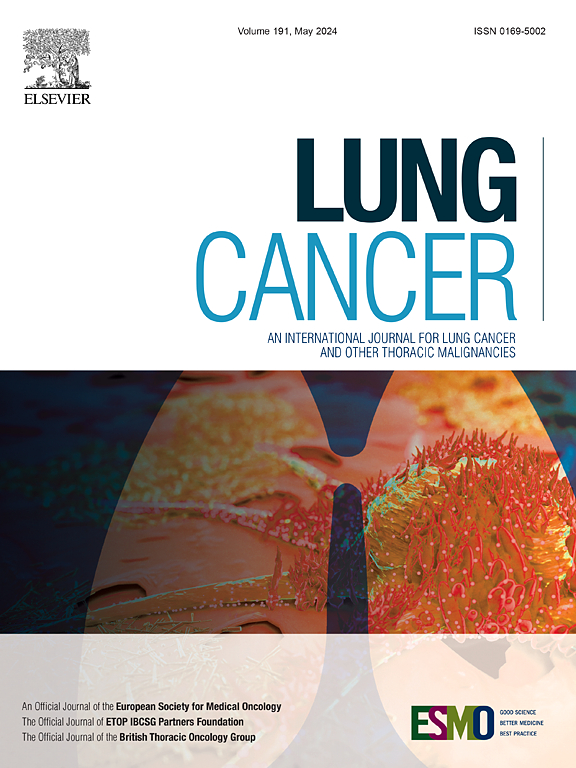Icotinib plus chemotherapy as neoadjuvant treatment for resectable stage II-IIIB EGFR-mutant lung adenocarcinoma: a phase II study (NEOIPOWER)
IF 4.4
2区 医学
Q1 ONCOLOGY
引用次数: 0
Abstract
Background
EGFR tyrosine kinase inhibitors (EGFR-TKIs) have shown activity in the neoadjuvant setting of EGFR-mutant (EGFRm) non-small cell lung cancer; however, data on the combination of neoadjuvant EGFR-TKIs plus chemotherapy are limited. This study aimed to evaluate the safety and efficacy of neoadjuvant icotinib plus chemotherapy for stage II-IIIB EGFRm lung adenocarcinoma.
Methods
NEOIPOWER is a single-arm, phase II study (NCT05104788). Eligible adult patients with resectable, stage II-IIIB, EGFRm lung adenocarcinoma received 8 weeks of 125 mg icotinib three times daily plus two 21-day cycles of chemotherapy (pemetrexed 500 mg/m2 and carboplatin AUC5 on day 1), followed by surgical resection. The primary endpoint was major pathologic response (MPR) rate. Secondary endpoints were R0 resection rate, objective response rate (ORR), pathologic complete response (pCR), disease control rate (DCR), disease-free survival (DFS), overall survival, and safety.
Results
From October 25, 2021, to April 2, 2023, 30 patients were enrolled and completed neoadjuvant therapy. MPR was observed in 6.7 % of patients (95% CI, 0.8–22.1%), which did not meet the primary endpoint. No patients had pCR. Twenty-eight (93.3 %) patients underwent surgery, of whom 27 (96.4 %) achieved R0 resection, and pathological downstaging was observed in 10 (35.7 %) patients. The ORR was 83.3 % (95% CI, 65.3–94.4 %) and DCR was 96.7 % (95% CI, 82.8–99.9 %) among 30 treated patients. With a median follow-up of 25.0 (range, 6.4–33.6) months, the median DFS was not reached (95% CI, 25.1-not estimable), and the 2-year DFS rate was 92.0 %. Grade 3 treatment-related adverse events (TRAEs) were reported in 6 (20.0 %) patients and mainly included leukopenia (6.7 %) and neutropenia (6.7 %). No grade 4 or 5 TRAEs were observed, and no deaths occurred.
Conclusion
Neoadjuvant icotinib combined with chemotherapy did not meet its primary endpoint for MPR rate in resectable stage II-IIIB EGFRm lung adenocarcinoma, but demonstrated a manageable safety profile.
伊可替尼联合化疗作为可切除II期- iiib期egfr突变肺腺癌的新辅助治疗:一项II期研究(NEOIPOWER)
背景:degfr酪氨酸激酶抑制剂(EGFR-TKIs)在egfr突变(EGFRm)非小细胞肺癌的新辅助治疗中显示出活性;然而,关于新辅助EGFR-TKIs联合化疗的数据有限。本研究旨在评价新辅助伊可替尼联合化疗治疗II-IIIB期EGFRm肺腺癌的安全性和有效性。sneoipower是一项单组II期研究(NCT05104788)。符合条件的II-IIIB期EGFRm肺腺癌成年患者接受8周125mg伊可替尼治疗,每日3次,加上2个21天周期的化疗(培美曲塞500mg /m2,第1天卡铂AUC5),然后手术切除。主要终点为主要病理反应(MPR)率。次要终点为R0切除率、客观缓解率(ORR)、病理完全缓解(pCR)、疾病控制率(DCR)、无病生存期(DFS)、总生存期和安全性。结果从2021年10月25日至2023年4月2日,30例患者入组并完成新辅助治疗。6.7%的患者出现MPR (95% CI, 0.8-22.1%),未达到主要终点。没有患者进行pCR。28例(93.3%)患者接受手术治疗,其中27例(96.4%)患者实现R0切除,10例(35.7%)患者病理分期降低。在30例接受治疗的患者中,ORR为83.3% (95% CI, 65.3 - 94.4%), DCR为96.7% (95% CI, 82.8 - 99.9%)。中位随访25.0个月(范围6.4-33.6个月),中位DFS未达到(95% CI, 25.1-不可估计),2年DFS率为92.0%。6例(20.0%)患者报告了3级治疗相关不良事件(TRAEs),主要包括白细胞减少(6.7%)和中性粒细胞减少(6.7%)。未观察到4级或5级trae,未发生死亡。结论新辅助伊可替尼联合化疗在可切除的II-IIIB期EGFRm肺腺癌的MPR率未达到其主要终点,但显示出可控的安全性。
本文章由计算机程序翻译,如有差异,请以英文原文为准。
求助全文
约1分钟内获得全文
求助全文
来源期刊

Lung Cancer
医学-呼吸系统
CiteScore
9.40
自引率
3.80%
发文量
407
审稿时长
25 days
期刊介绍:
Lung Cancer is an international publication covering the clinical, translational and basic science of malignancies of the lung and chest region.Original research articles, early reports, review articles, editorials and correspondence covering the prevention, epidemiology and etiology, basic biology, pathology, clinical assessment, surgery, chemotherapy, radiotherapy, combined treatment modalities, other treatment modalities and outcomes of lung cancer are welcome.
 求助内容:
求助内容: 应助结果提醒方式:
应助结果提醒方式:


